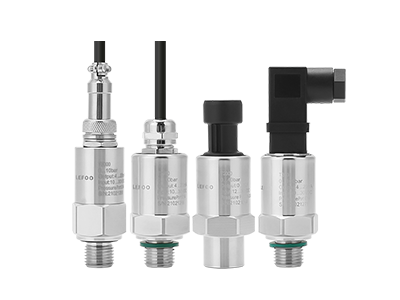The literal definition of a pressure sensor is a device that undergoes a physical force on a certain area and translates it to a basic energy signal. The smart pressure sensor consisting of a pressure-sensitive silicon wafer, for a liquid pressure sensor, requires a diaphragm and filled oil, and PCB to convert information from the silicon wafer into an output signal. The working principle of the pressure sensor is based on the Wheatstone bridge. The basic energy signal of a pressure sensor can be 4-20 ma.
The pressure transmitter consists of a pressure sensor that uses additional electronics to compensate for linearity deviations and temperature errors, outputting measurement results as higher-level signals. Every transmitter made by a professional pressure transmitter manufacturer is measured over the entire pressure and temperature profile and compared to the desired signal span. The higher energy signal of a pressure sensor can be 0-10 V, 0.5-5V, RS485 or other customized signals.
However, many people use the name of the pressure sensor to define all classes of pressure transducers and pressure transmitters, Actually, the definition of pressure transmitter first appeared in scientific papers and is popular in the scientific research circle. However, as the application of pressure transmitters becomes well known to the general public, people are also keen to use the vocabulary of pressure transmitters.
A pressure transducer converts the physical force of pressure into a continuous voltage output (V). The DC voltage output of a water level pressure transducer is typically amplified into industry-standard outputs such as 0-5V or 0-10V. Voltage output signals, such as 0-5V, do not have a "live zero" where there is a signal when the sensor is at zero pressure. The risk is that the system does not know the difference between a failed sensor with no output and zero pressure. We can add a conversion interface to change the signal into a high-level voltage or frequency output signal including 0.5 to 4.5V ratiometric (output signal is proportional to the supply), 1-5V, and 1-6kHz. These output signals should be used within twenty (20) feet of the electronics. Voltage output signals can offer low current consumption for remote battery-operated equipment such as wellhead SCADA systems. Supply voltages are typically from 8-28VDC, except for the 0.5-4.5V output, which requires a 5VDC regulated supply. submersible pressure sensor
The industrial and biological definition of pressure is the applied force by a liquid or gas on a surface and it is usually measured in units of force per unit of surface area. Common units are Pascal (Pa), Bar (bar), Mpa, or Psi (pounds per square inch).
The temperature has a more obvious impact on the measurement accuracy of the pressure sensor, and the signal of the pressure sensor cannot be transmitted over a long distance. The primary signal of the sensor is easily affected by electronic equipment, so it cannot be installed in scenes surrounded by more electronic equipment. The price of the pressure sensor is much lower than a pressure transmitter. Pressure transmitters are signal amplified, so the signal can be transmitted over a long distance without electronic interference, and the measurement accuracy can be maintained under extreme temperatures after temperature compensation.
Application of HVAC Differential Pressure Sensors-differential pressure sensor HVAC
Importance of Pressure Sensor in HVAC System-hvac pressure sensors
Principle Analysis of Different Types of Pressure Sensors-types of pressure sensor
More Related Products

 English
English  français
français  Deutsch
Deutsch  Español
Español  italiano
italiano  русский
русский  português
português  العربية
العربية  Türkçe
Türkçe  Zulu
Zulu 